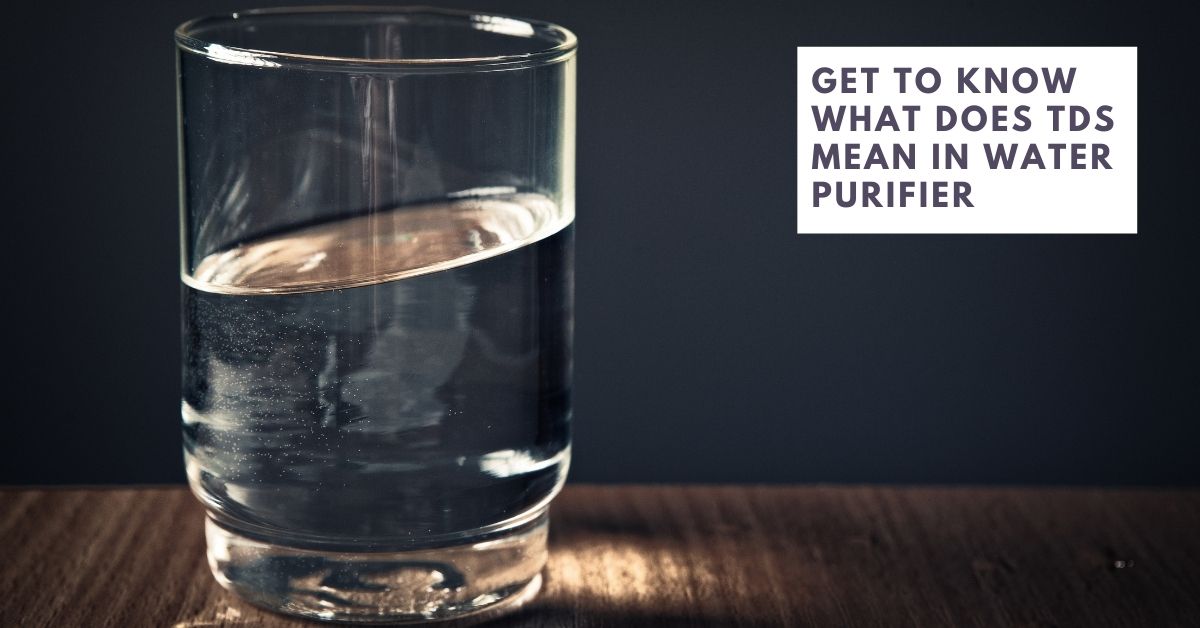During these times, it is so hard to find clean and pure drinking water. You can always see the reports that water is always affected by chemical impurities and other harmful microorganisms. Water filtration is a much-required process, so let us understand one of its techniques – what is TDS in water purifier?
Filtration of water is a much-needed process. Because, in order to eradicate all harmful impurities and viruses, water filtration is one of the best ways to ensure that you get clean and pure drinking water.
TDS is a term that is so popular across the web in terms of water purification. Whenever you see any water purification guide, you will overcome the term TDS. Because the presence of TDS is one of such subjects that has its own advantages and disadvantages.
In short, TDS is something that is used to measure the levels of water quality whether it is soft or hard. Determinantal factors are completely dependant on TDS levels of water. If you find the TDS quantity at a huge level that means water is hard. Likewise, if you find the TDS quantity at a low level, that means water is soft.
In this blog post, you will learn everything about TDS water purification, how it works, FAQs and its benefits. So without further ado, let us understand what is TDS in water purifier.
What is TDS in water purifier?
Before understanding what is TDS in water purifier, let us understand the concept of TDS.
TDS is an abbreviation for total dissolved solids. These can be impure elements that are dissolved in water which consists of all the essential nutrients and minerals + harmful impurities as well.
The process in which water gets all these elements is when it passes through several mediums like tank water, land surface water or so on. So when the water passes through these many mediums, it extracts all the elements with it. These elements can be pure or impure.
As water tends to attract impure material instantly, TDS filtration is a must. TDS can be of any form, like, salts, metals, minerals any other materials which are completely dissolved in water. That can be even harmful chemicals also found in water. As in water, these harmful elements can be the good or bad elements that are dissolved very easily. That’s the reason TDS filtration is much required.
Generally, impure material which is sized more than 2 microns is known to be TDS. A TDS water purifier can filter out these total dissolved solids particles easily. When there is any presence of large-sized impure particles is the reason for the water to be hard.
TDS water purifier is one of the effective techniques to eliminate these total dissolved solids in water that are originating from multiple platforms.
How does the TDS controller work in a water purifier?

TDS controller works closely with the RO water purification process. As you can find in full-fledged water purifiers, TDS operates between two sections. When I term full-fledged, it can be RO+UV+UF purification of water technique.
The first section is where the RO process actively works. In this section, the water passes through RO water purification and all the elements that are present in water are removed. Here the process will result in the loss of the complete TDS from the water. TDS doesn’t know which is the good or bad element in water that are required for the human body.
So to regain this, section B takes an active role in water purification. After the water has been filtered out in section A, the water goes to Section B where you can find UV + UF filtration. This technique helps to regain the necessary minerals and vitamins that were lost in the RO process. It ensures that the water which is filtered out from section B is completely suited for drinking purposes.
RO water purification removes up to 90% of TDS materials. Both the sections are controlled in such a way that TDS levels are reduced without any important minerals lost. The main objective of TDS filtration is to remove the dissolved solids that are present in the water.
What are the benefits of TDS water purification?
TDS is one of the major components that need to be filtered out. Because the presence of TDS isn’t recommended for humans or non-human interaction. Let us know the following benefits of eliminating TDS.
Helps to get soft consumable water
As we discussed earlier, TDS constitutes different levels, the higher level denotes the water is hard, and the lower level denotes the water is soft. TDS is one of the best methods of water purification to obtain soft water.
Sometimes you can feel the taste gets differed in water, this is all due to the levels of TDS that are present. TDS purifier helps on a larger scale to improve the taste of water by eliminating the dissolved solids.
So with the help of a TDS water purifier, you will be able to get soft water that is suited for consumption. This is a much-required water purification technique in a water purifier.
Good for health
When the TDS are eliminated by the water purifier, this is best suited for consumption by you and your family. If you get a water purifier that has UV or UF filtration, you tend to get more clean and pure water.
But TDS filtration helps majorly in getting all the dissolved solids eliminated. With the presence of dissolved solids, you can get water-borne diseases that are bad for the human body.
Can be utilized for cooking and washing
After the TDS water purification, you can use the water for cooking purposes. This is best suited for cooking as you need not worry about the taste factors associated with it. A high level of TDS tends to change the taste of the food. So, the TDS filtration technique of water is required to preserve the taste when cooking.
You can observe that sometimes utensils are stained with a white-coloured surface. This is due to the TDS presence in the water. This doesn’t only stain your utensils but also so affects their quality. That’s the reason, you require water that is TDS purified water so that you can wash utensils peacefully.
Get the best TDS Water Purifiers here
FAQs of TDS water purifier system
These are some of the common queries faced by consumers while shopping for a TDS water purifier.
Do I need to measure the TDS level of water in my home or office?
It is ideally recommended that you need to measure the TDS level of water irrespective of home or office.
TDS is something that can help in determining if the water is hard or soft. Depending on the factors, you can easily decide whether the water is suited for consumption.
If there is any high level of TDS, this can lead to a serious health problem. Due to the presence of harmful chemical elements, it makes it unfit for consumption of water. This affects the younger generation, elder people, a lot.
So you need to measure the TDS level and make a smarter decision of getting a water purifier.
What are the harmful chemical elements found out in the water?
Some of the harmful elements can be sodium, chloride, lead, and many other elements.
When the presence of such elements, the water is not recommended for consumption. This deteriorates your health on a larger scale.
What are the measuring level metrics to determine the TDS of water?
If you can measure the TDS level and when you find the following results, it helps to determine the quality of water.
The presence of a TDS level of less than 250 million PPM, is suitable for the consumption of water. Remember that lowering the TDS level is much better for consumption purposes.
If you find the presence of a TDS level of more than 300, it is not recommended for drinking. This level of TDS presence in water can affect your health.
How should I choose a water purifier based on the TDS level?
When you are shopping for a water purifier, it is essential that you need to check the levels of TDS present in water. Because different levels of water require a different type of purifier.
Below are some of the stats which will help you to decide for selecting the desired water purifier
If you find the TDS level up to 200, you can go for a UV water purifier.
When the TDS level is between 200 to 300, it is ideal for you to take our RO + UV water purifier.
When you find the TDS level above 300, RO + UV + UF technique is required in a water purifier.
How does the water get dissolved with impure materials?
Usually, the water is extracted from a river or groundwater. And that source of water is being dumped with the sewage waste, industrial chemically treated wastewater and so on. When this water passes through to the piping across regions, it tends to acquire several kinds of impure materials.
Usually, the chemical elements and even the presence of salt are all absorbed during this process. That’s the reason TDS filtration is a much-required process for Municipal tap water or even ground borewell water.
What are the different ways to remove TDS of water?
Some of the techniques can be reverse osmosis (RO), distillation, and the de-ionization process. These are the techniques that help in removing the TDS level of water.
The reverse osmosis process focuses on filtering water by passing it through a semipermeable membrane. The distillation technique focuses on boiling the water that creates vapour and that vapour is ensured that it comes back to a liquid state and stays in a boiling position. Deionisation is a process where the water comes in contact with positive and negative electrodes, the ions help to remove impurities.
All the above 3 techniques are utilised to eliminate the presence of TDS from water.
Currently, in the market, the best-suited technique for residential and commercial purposes would be the RO filtration process.
To sum it up
Measuring the TDS levels would be an ideal way to determine the quality of water.
TDS levels can cause severe health problems for everyone. Depending on the levels of TDS in water, it is recommended to choose a water purifier that serves the need.
If you don’t want the hassle of going through all the processes, then we can recommend you to go for a water purifier that has the RO+UV+UF filtration techniques.
Let me know in the comment section which water purification would be best for you.
Related:

